Quick Pickled Green Beans
Want to learn how to quick pickle green beans? This simple refrigerator pickling recipe uses four simple steps for easy green beans pickles.
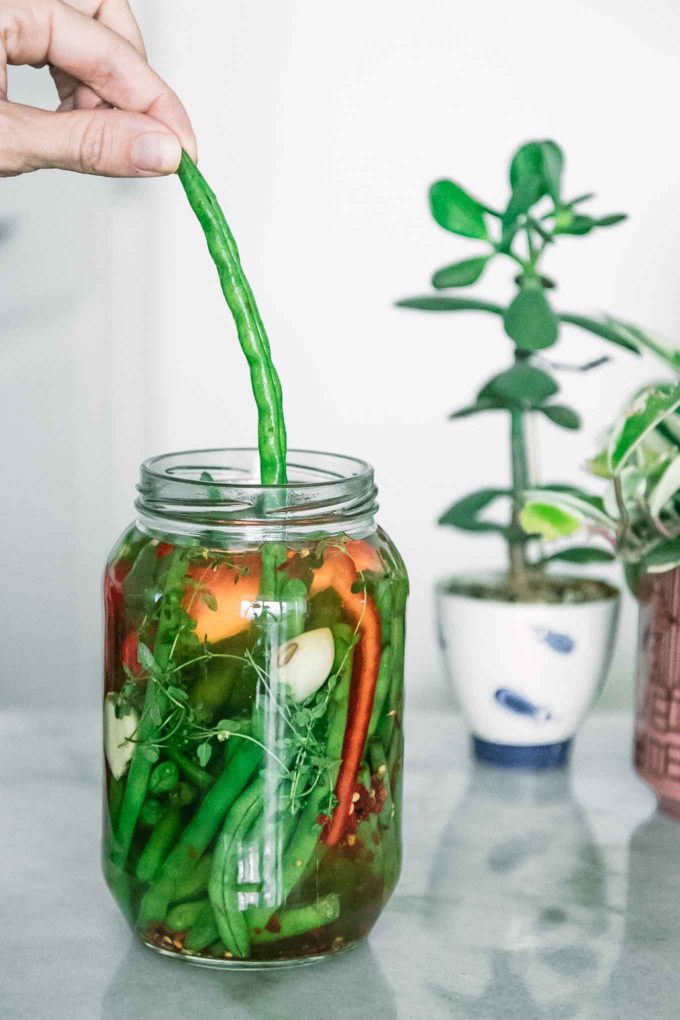
Want to Save This Recipe?
Enter your email & I’ll send it to your inbox. Plus, get new plant-based recipes in your inbox!
By submitting this form, you consent to receive emails from Fork in the Road.
Love green beans? We can’t get enough of the crunchy beans during the spring growing season, and we’re always looking for ways to enjoy fresh green beans throughout the year. However, we find fermenting and canning to be intimidating, but thankfully there’s a super easy way to enjoy pickled green beans at home!
👉 To quick pickle green beans, simply follow these four easy steps:
- Prepare the green beans by cutting off the stems
- Add the green beans and any herbs and spices to a tall jar
- Boil a salted vinegar brine and pour over the green beans
- Refrigerate for at least 24 hours and keep for up to one month
Ready to deep dive into how to quickly pickle green beans? Let’s do it!
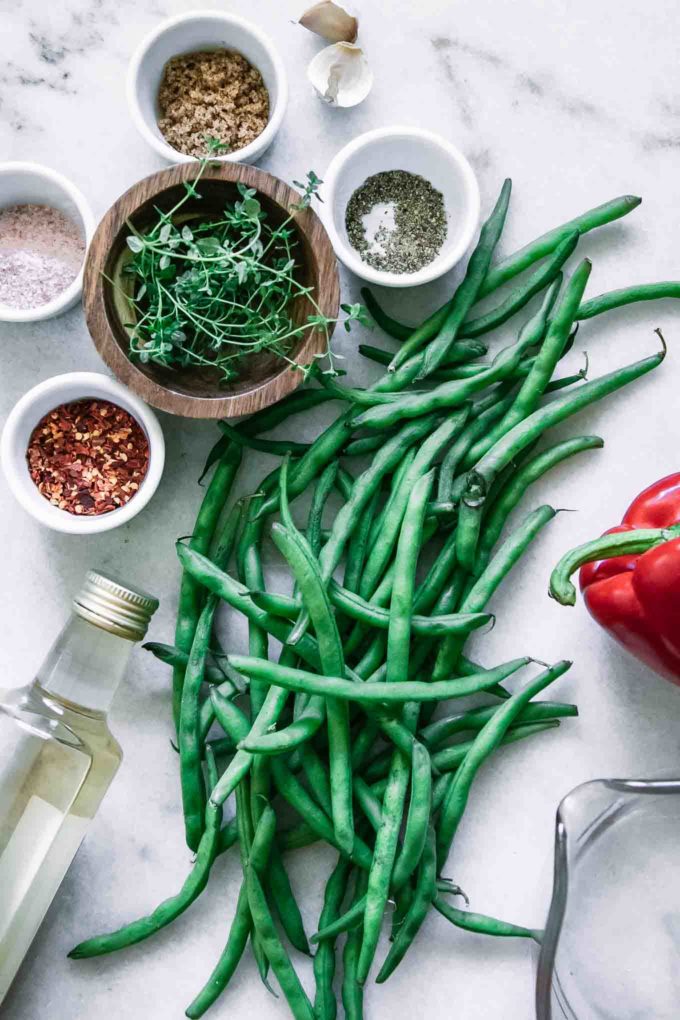
🥣 How to make (step-by-step photos)
1️⃣ Step One: Cut the green beans to fit the jar.
The first step to making easy refrigerator pickled green beans is to prepare them by washing and cutting off the stems.

♻️ Sustainable cooking tip: Don’t waste those stems! Save your green bean stem scraps to use in food scrap vegetable broth. Close the loop on food waste!
2️⃣ Step Two: Prepare the pickling jar
Next, add the destemmed green beans to a tall jar with thyme or other herbs, garlic, and red pepper flakes. You can also add other vegetables to the jar if you’d like, we like adding sliced radish, bell peppers, or even lime or lemon slices.
You’ll want to make sure to use a glass jar with a lid that allows the green beans to fit with about ½ – 1 inch of space so you can completely cover them with brining liquid (or the water and vinegar mixture that works the magic of pickling vegetables).
Any pieces of vegetable that extend out of the top of the water will not be pickled and could grow mold or other bacteria while storing, so make sure there’s enough space.
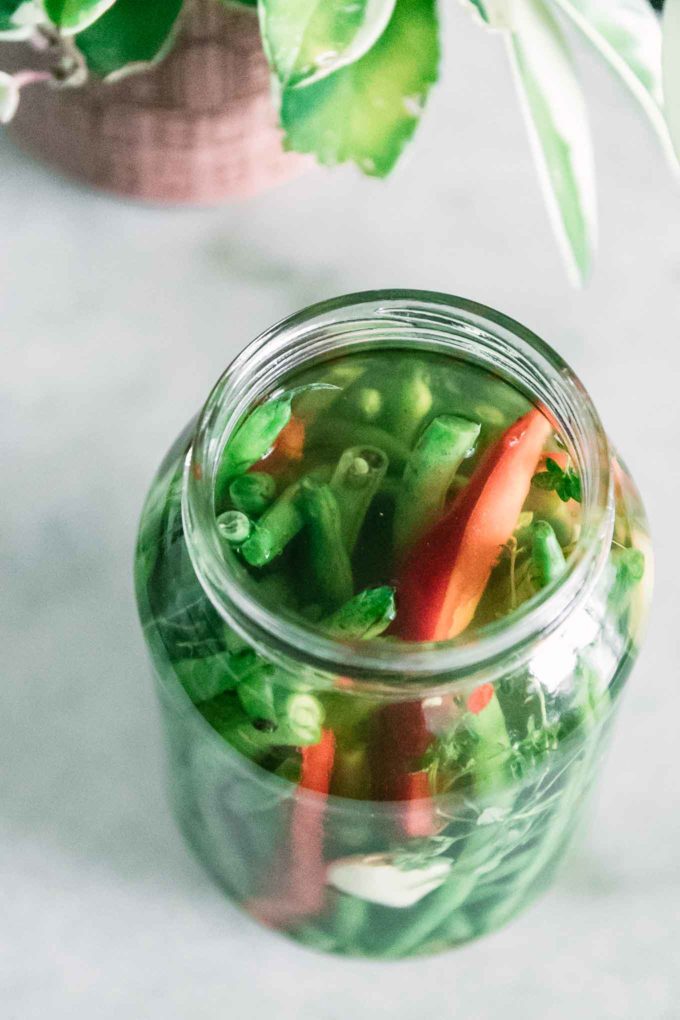
3️⃣ Step Three: Prepare and add the brine
Now it’s time to make the brine, or the salted and sugared vinegar water that will work the magic of pickling your green beans.
The foundational vegetable pickling brine recipe we use is:
- 1 cup water
- 1/2 cup vinegar (distilled vinegar, white wine vinegar, and apple cider vinegar are our favorites)
- 1 tablespoon salt
- 1 tablespoon sugar
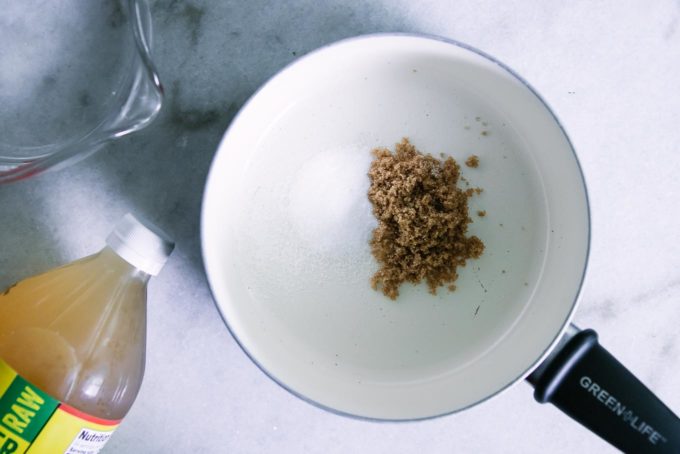
We increase or decrease the amount of brine depending on the amount of beans we’re pickling, but this is the general formula we use that always produces great tasting pickled vegetables.
To make the brine, simply add water, a vinegar of your choice, salt, and sugar to a medium saucepan and bring to a boil.
💡 Want more tips for making pickling brine? Check out my full recipe, tips, and advice for making a refrigerator pickling brine here.
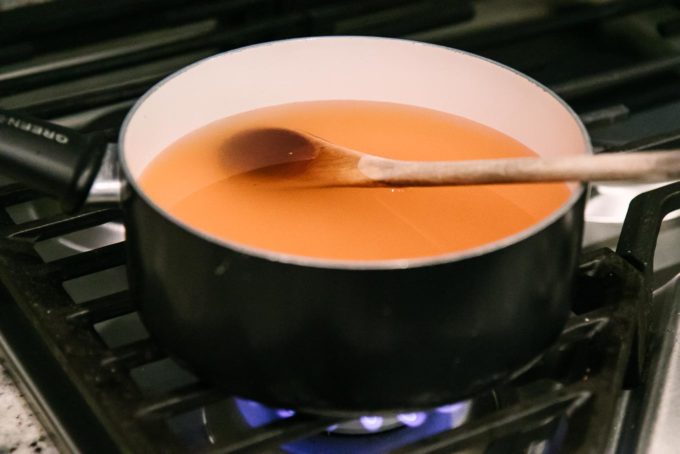
Pour the hot brine into the jar and completely cover the green beans, then close the lid tightly and let cool completely on the counter until it reaches room temperature.
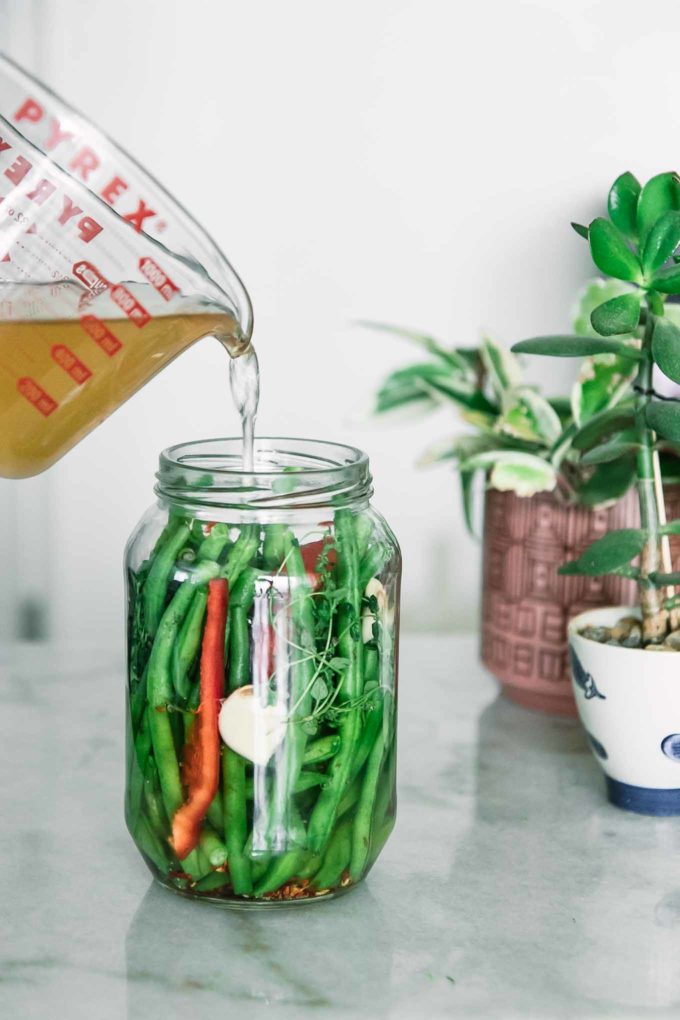
Which vinegar should you choose? For the mildest flavor choose distilled white vinegar. For more of a flavor punch try apple cider vinegar or white wine vinegar (our favorite for pickling green beans). Malt and balsamic vinegar have the strongest flavor, but we have found the taste of these vinegars is too strong when quick pickling.
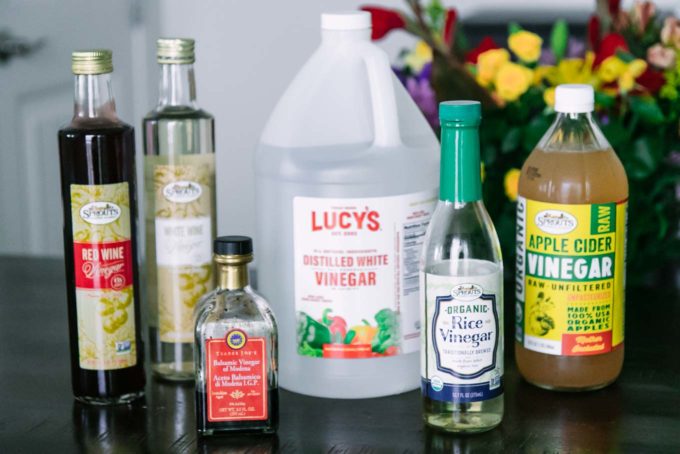
4️⃣ Step Four: Refrigerate to quickly pickle the green beans
Once the jar of green beans is cool, store in the refrigerator and let the green beans pickle in the salted vinegar brine.
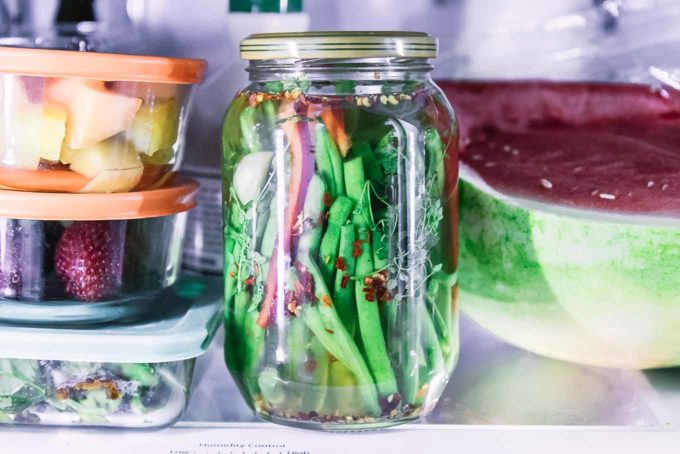
If you want to serve quickly we recommend letting the green beans ferment for at least 4 hours to let the beans soak up the brine, but for best results and flavor wait at least 24-48 hours. Pickled green beans are good for up to one month in the refrigerator.
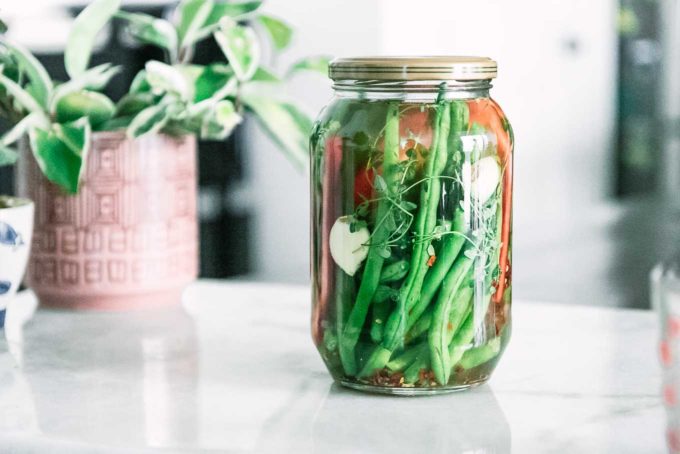
❓ Questions + quick tips
Blanching, or boiling the green beans for a few minutes, before pickling will help them retain their green color. However, we’ve tested pickled green beans both ways and have found that the color variation is so slight that it’s not worth this extra step unless you’re very worried about the presentation. The taste is the same, which is the important part!
Choose a jar tall enough to store the pickled green beans spears with about ½ – 1 inch of space between the top of the spear and the lid so that the brine liquid can completely submerge the beans.
You can eat the pickled green beans as soon as 4 hours after pickling, however we suggest waiting a minimum of 24 hours for best results. If your green beans are thin, then less time is needed for good flavor. However, if your green beans are thick then they may need more time to soak before they are fully pickled.
Pickled green beans last up to one month in the refrigerator as long as they are completely covered with the liquid brine. However, if the spears are sticking out of the water you’ll run the risk of bacterial growth, so make sure to choose a tall jar and to completely submerge them in the brine.
Pickled green beans are healthy! Per the USDA Food Nutrient Database, one cup of green beans has 2 grams of plant-based protein, 2.7 grams of fiber and is a good source of vitamin C and vitamin A. However, the brine is high in sodium due to the salt needed to pickle the vegetable, so use as a compliment to meals or eat a few green beans spears as a snack with a well-balanced diet.
It’s possible to pickle any type of green beans: pole, snap, bush — you name it, you can pickle it. However, the varieties most commonly used are Blue Lake and Kentucky Wonder.
Quick pickling vegetables does not come with the same food safety hazards as traditional pickling and canning. However, to make sure your green beans stay safe while stored in the refrigerator make sure to completely cover in the liquid brine and to feel the green beans spears before eating. If they’re slimy, throw them out.

💡 Ideas for serving
Quick pickled vegetables like green beans are great additions to salads, bowls, or are even a great simple snack. Here are a few recipes and ideas to get you started:
- On a large fruit, vegetable, and nut platter. Use quick pickled green beans as a pickable vegetable on a large platter with assorted seasonal fruits, vegetables, nuts, seeds, and crackers.
- Add to a salad or bowl. Top a salad or grain bowl with pickled green beans, like this Roasted Fennel Beet Salad or Easy Lentil Bowl.
- Snack on green beans stalks. Grab a few pickled spears and a handful of nuts or seeds for a deliciously salty plant-based snack.
♻️ Sustainable kitchen tips + tricks
While pickling seasonal vegetable is sustainable in itself, there are a few tips and tricks you can learn to make this green beans recipe even more environmentally friendly:
- Take advantage of green bean season! The best time to make fast pickled green beans is during the height of green beans season. In California that’s actually year round, but check out Seasonal Food Guide’s produce seasonality calendar to find when green beans are in season near you.
- Save tall food jars to use for quick pickling vegetables. We’re always on the lookout for great jars to keep around the house for pantry and food storage, so keep an eye out for a taller jar you can save to use for pickling green beans (tip: we used an empty Costco artichokes jar and use this easy method for removing paper labels from glass jars).
- Save the green beans stems for soups and broths. Don’t throw out the cut off green beans stems, save them to flavor soups and broths like our homemade vegetable broth made from food scraps.
👉 More refrigerator pickling recipes
Check out our other easy simple refrigerator pickled vegetable recipes:
- Quick Pickled Asparagus
- No Cook Refrigerator Pickles (i.e. quick pickled cucumbers)
- Spicy Quick Pickled Cauliflower
- Easy Pickled Peppers (Whole or Sliced)
- Quick Dill Pickled Radish (Whole or Sliced)
- Easy Quick Pickled Carrot Ribbons
- Quick Pickled Grapes
- Sugar-Free Refrigerator Pickled Red Onions
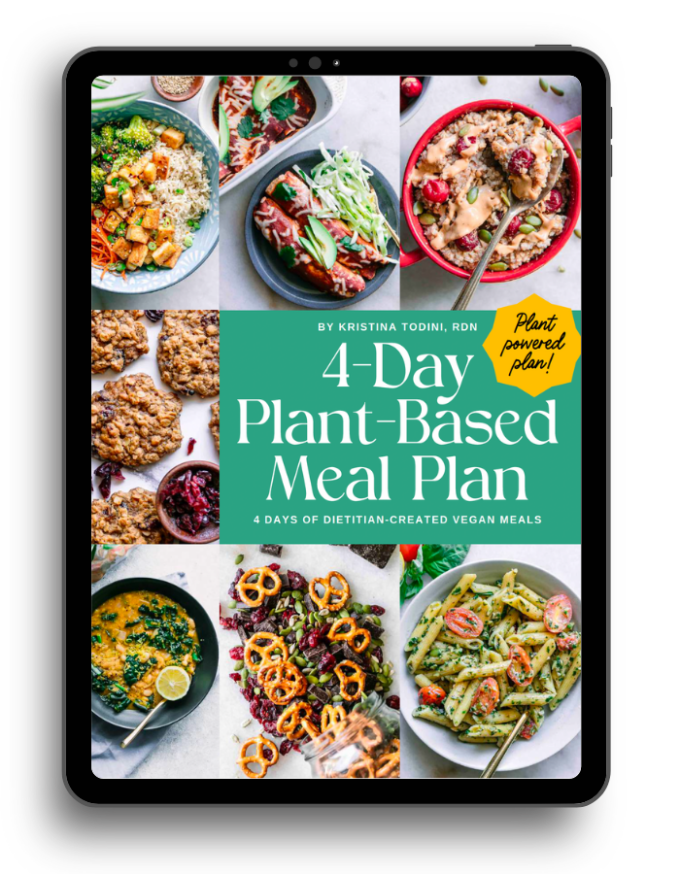
NOT SURE WHERE TO START WITH PLANT-BASED EATING?
Get my 4-Day Plant-Based Meal Plan to start your journey on the plant path.
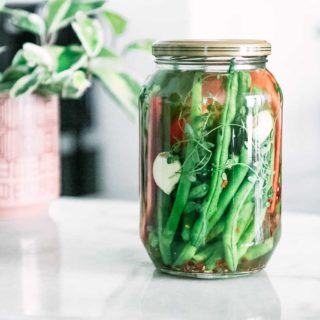
Quick Pickled Green Beans Recipe
Equipment
- 1 sauce pan
- 1 large glass jar
Ingredients
- 1 pound green beans
- 2 tablespoons thyme or other herbs
- 2 whole garlic cloves sliced thin
- ½ teaspoon red pepper flakes
- 2 cups water
- 1 cup vinegar see notes
- 1 tablespoon salt
- 1 tablespoon sugar
- Optional: sliced radish, bell pepper, carrots, or other vegetables
Instructions
- Cut the green beans: Wash green beans and remove the stems, making sure the green beans will fit into the desired pickling jar with room for water to completely cover the spears.
- Prepare the pickling jar: Add cut green beans to a tall jar and add thyme or other desired herbs, garlic, and red pepper flakes.
- Prepare and add the brine: In a medium saucepan bring the water, vinegar, salt, and sugar to a boil. Once boiling, pour into the jar until the liquid completely submerges the green beans. Close the lid on the jar tightly.
- Pickling instructions: Let the jar cool on the counter until it reaches room temperature. Once cooled, put the jar into the refrigerator and let the green beans pickle for at least three hours before serving, but for best results serve after at least 24 hours. Quick pickled green beans are good up to one month in the refrigerator.
Notes
- Vinegar recommendation: White vinegar, white wine vinegar, and apple cider vinegar are the best vinegar choices for this pickled vegetable recipe.
- Recommended jar: Because green beans are a tall vegetable, choose a tall jar and destem the beans so it fits within the jar with about ½ – 1 inch space (2-3cm) below the lid.
- Other recommended tools: small saucepan, cutting board, knife set
- Prep ahead and storage: Refrigerator pickled green beans should be made at least 4 hours before serving, but for best results make at least 24 hours ahead. Keep the jar refrigerated and it can be enjoyed for one month. Do not freeze.
- Nutrition notes: The nutrition information for this recipe was calculated with the full amount of salt and sugar used in the brine. However, the actual amounts absorbed by the green beans is much less.
Nutrition
UPDATE: This recipe was originally posted in June 2020 and was updated for clarity in January 2022.

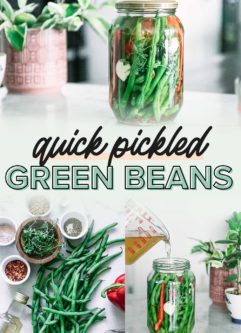
I have this recipe doing its magic at work in the walk-in as I type this.
Will family meal be a disaster or a well thought out stroke of success and bonhomie?? Stay tuned to find out!!
I took the remaining ~1.25# of green beans on my station and used your ratios given in this recipe, adjusting for spice level and herbs on hand.
Substitutionally, I used 3/4 apple cider vin and the ramainder balsamic vin. Chucked in a good hank of thyme and some dried dill.
Kitchens closed Sunday Monday so I can report back Tuesday.
Thank you.
Hope it turned out well, Ray!
The nutrition note refers to salt and sugar being absorbed by the “asparagus.” I assume the basic recipe will work as well for asparagus as for green beans, but I had a moment of confusion there.
Yes, I used your basic recipe. I’ve only had a preliminary taste, but I think it will turn out well.
Yes, a typo! Thanks for the note, David. I hope they turned out well for you.
I just made this recipe pickling green beans and small cucumbers in quart mason jar. I had never pickled anything before. I put vegs in jar along with various spices. Filled jar to within half inch of top and firmly put on lid. All the vegs then floated to top. They are at least an inch from bottom. I am concerned some may be exposed above liquid. Any suggestion?
Hi David, if they’re floating to the top but still mostly submerged in liquid then you’re fine. It’s when they’re only half submerged and the green beans are exposed to air for weeks, or up to a month, then you would need to be concerned about food spoilage. I hope that helps.